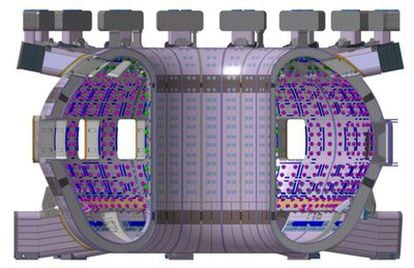Graphic representation of the vacuum vessel of the ITER experimental nuclear fusion reactor.
The fusion reactors that are currently being worked on are of an experimental type and do not yet generate energy to inject into the electricity grid, but there is an international roadmap that establishes the phases until reaching the first commercial one.
This entails going through ITER, an experimental fusion reactor being built in France, which is expected to generate the first plasma in 2025 and in which, in addition to the European Union, the United States, Japan, China and , India, Russia and South Korea.
ITER aims to be the first reactor in which a fusion process with positive efficiency is demonstrated, that is, one that generates more energy than is needed to maintain the plasma (a mixture of deuterium and tritium at millions of degrees).
The next step will be to build a demonstration reactor, DEMO,
Doing a bit of history, fusion energy research had a major boost during the oil crisis of the 1970s.
But fusion as a source of energy has been a more complex challenge than anticipated.
This has forced a redesign process to address each difficulty that has arisen.
But it is also true that the advances that have taken place in both physics and engineering have made it possible to overcome them.
As an example, the containment of plasma requires the use of enormous magnetic fields, in fairly large spaces, and this challenge has been facilitated by advances in superconductivity, thanks to which very powerful electromagnets have been achieved.
Going into the operational aspects of fusion reactors, these aim to generate electricity and, in this, they are not very different from current nuclear reactors, where it is fission (rupture of nuclei of heavy materials) that generates the necessary energy for electricity production.
But the comparison only goes so far, since constructively they are very different.
In a fusion reactor, the hot plasma is magnetically confined inside a vessel where what we call ultra-high vacuum has been drawn, which is the maximum that can be achieved.
As a result of the fusion reactions, neutrons are produced that come out of that collision with a lot of energy and impact a prepared wall in which said energy is captured.
From there the process is already as in fission nuclear energy,
A fusion reactor has an added technological complexity that, however, in practice, is a tremendous advantage: it is the regeneration of the fuel during the fusion process.
Tritium is an element that does not exist in nature and that is obtained precisely in fission nuclear power plants.
What might seem like a great contradiction (needing fission reactors for fusion reactors to work) is resolved because devices called regenerative mantles have been designed in fusion reactors that cover the first wall of the chamber where the plasma is and whose mission is precisely to regenerate tritium.
This is done thanks to the energy of the surplus neutrons from the fusion process (deuterium + tritium → helium + neutron + energy) favoring another reaction within these devices that regenerates tritium from a circulating mixture of lithium-lead to reinject it back into the plasma.
In this way, we will only need to produce a little tritium to start the fusion.
Our primary fuels would be deuterium (from water) and lithium.
One of the advantages of fusion energy compared to the burning of fossil fuels, which are the cause of climate change, is that it does not emit CO₂.
In addition, the fusion does not have chain reactions that require complex reaction stoppages and does not generate high-activity residues.
In a fusion reactor, in the event of a failure, the reaction spontaneously shuts down, since the plasma itself is very "delicate" and the slightest disturbance causes it to cool and die.
I am very confident that the first fusion reactor capable of generating electricity for the grid will see the light of day soon, and present us with a truly sustainable alternative to fossil fuels that have such an impact on climate change.
Isabel García Cortés
is a Ph.D. in Physics and a researcher at the CIEMAT National Fusion Laboratory.
Question sent via email by
Javier Cordovilla
Coordination and writing:
Victoria Toro
We respond is a weekly scientific consultation, sponsored by the Dr. Antoni Esteve Foundation and the L'Oréal-Unesco 'For Women in Science' programme, which answers readers' questions about science and technology.
They are scientists and technologists, members of AMIT (Association of Women Researchers and Technologists), who answer these questions.
Send your questions to us at
nosotrasrespondemos@gmail.com
or via Twitter #nosotrasrespondemos.
You can follow
MATERIA
on
,
and
, or sign up here to receive
our weekly newsletter
.

